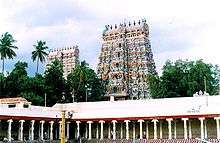Koil
Koil or Koyil or Kovil, (meaning: residence of God[N 1]) is the Tamil term for a distinct style of Hindu temple with Dravidian architecture. Both the terms koyil (கோயில், kōyil) and kovil (கோவில், kōvil)[1] are used interchangeably. In Tamil language, kōvil (wikt:ta:கோவில்)[2] is the word derived, according to the rules of Tamil grammar.[N 2]

| Wikimedia Commons has media related to Hindu temples in Tamil Nadu by district. |
| Look up kovil in Wiktionary, the free dictionary. |
In contemporary Tamil, the term 'kōvil' is also used to refer to "Place of Worship". In modern formal speech, kōvil is also referred to as aalayam, dheva sthaanam by many Hindus. Ambalam is another term used by devotees of the 19th century Tamil monk Vallalar. Another term is 'Thali', (தளி)[3][4] which also means temple.
To Shaivites, the foremost kōvils are Chidambaram temple and Koneswaram temple while for Vaishnavites, Sri Ranganathaswamy temple, Srirangam and Tirumala Venkateswara temple, Tirupati are viewed as important.
The kōvils in Tamil Nadu and the kōvils of Sri Lanka have long histories and have always been associated with the ruler of the time. Most kings patronised temple building in their kingdom, and attached water tanks and villages to the shrine to administer.
There are over 36,488 Temples in Tamil Nadu alone as registered by Hindu Aranilaya Thurai. The Sangam literature scripted before the common era, refers to some of the temples the early kings of Tamilagam had erected. The songs of the revered Shaiva Nayanars and the Vaishnava Alvār saints that date back to the period 6th to the 9th century CE, provide ample references to the temples of that period. Stone inscriptions found in most temples describe the patronage extended to them by the various rulers.
The most ancient temples were built of wood as well as brick and mortar. Up to about 700 CE temples were mostly of the rock-cut type. The Pallava kings were great builders of temples in stone. The Chola dynasty (850-1279 CE) left a number of monuments to their credit such as the Brihadeeswarar Temple in Thanjavur. The Cholas added many ornate mandpams or halls to temples and constructed large towers. The Pandya style (until 1350 CE) saw the emergence of huge towers, high wall enclosures and enormous towered gateways (Gopurams). The Vijayanagar Style (1350 - 1560 CE) is famous for the intricacy and beauty especially for the decorated monolithic pillars. The Nayak style (1600 - 1750 CE) is noted for the addition of large prakaram (outer courtyard) (circum-ambulatory paths) and pillared halls.
See also
Notes
- The modern Tamil word for Hindu temple is kōvil (Tamil: கோவில்) meaning " the residence of God". In ancient Tamil Nadu, the king (கோ, Kō) was considered to be a ‘representative of God on earth' and lived in a kōvil, which also means "king’s house". Old words for king like Kō (கோ "King"), Iṟai (இறை "Emperor") and Āṇṭavan (ஆண்டவன் "Conqueror") are now primarily used to refer to God.
- "உடம்படுமெய்ப் புணர்ச்சி" என்ற தமிழ் இலக்கண விதிப்படி, "வ்" வரும், கோ + இல் = கோவில். உடம்படு மெய்: நிலைமொழியில் இ, ஈ, ஐ, இருந்தால் "ய்" யும்; ஏனைய உயிர்கள் (அ, ஆ, உ, ஊ, ஓ) இருந்தால் "வ்"வும்; "ஏ' இருந்தால் இரண்டும் (ஏதாவது ஒன்று) உடம்படு மெய்யாக வரும்.
Citations
- Koyil or kovil, which is correct? கோயில், கோவில்; எது சரி? Dinamani.com newspaper's Kadhir supplement.
- Correct word- Koyil or kovil? எது சரி? கோயிலா அல்லது கோவிலா? Dinamani.com newspaper's Tamil mani supplement.
- Thali, தளி= Kovil, given at Wiktionary wikt:ta:தளி and ValaiTamil.com Tamil dictionary.
- Metraleeswar temple, Kanchipuram. மேற்கு தளி, மெற்றாளி.